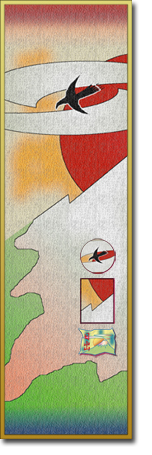On The Way: The Daily Zen Journal
The Stages of Meditation
Kamalasila (8th c)
The necessity of meditation
We should awaken the wisdom that comes from meditation so as to directly experience reality ourselves. All the teachings emphasize that even by much study and much consideration, one cannot experience reality directly. If the light of manifest knowledge does not begin to shine, we cannot cut through the darkness of our confusion, and it is through meditation that the light of manifest knowledge shines even upon objects which are not real; how much more upon what is really real! One who wishes to see reality face-to-face should set out to meditate.
Once the mind is made one-pointed and more supple, using different meditative objects, the bodhisattva attains to what are called formless meditations. One becomes filled with a feeling of equanimity and becomes detached from sensual craving and filled with enthusiasm and inner tranquility.
Insight meditation
When the mind is thus firmly fixed upon the meditative object, examine it with wisdom: for it is only where light of knowledge dawns that the seeds of delusion are wholly cast aside. Meditation by itself cannot destroy confusion. One who cultivates meditation, yet does not examine his concept of the self, will again be shaken by confusion.
The union of calm and insight
Calm and insight both work together to bring about true knowledge, as the eye sees with the aid of light.
In this experience of meditation, we understand reality as it really is, for in this state, we examine things with wisdom, and no event is perceived as real. This is the highest nonseeing, called the effortless state, for there is nothing to see beyond it. It is called tranquil, for all the busy work of the mind has been calmed, that which imposes upon reality the constructs of existence and non-existence.
When we examine the world with wisdom, we see no essence of any existing thing, nor do we impose any construct of existence upon reality, or nonexistence upon reality. We look with this eye of wisdom into the past, the present, and the future, and do not see anything which exists.
This is the process by which the bodhisattva should contemplate reality. And should giddiness or depression occur, calm yourself by the process we have discussed. When this knowledge takes the essencelessness of all events as its meditative object, and flows evenly and spontaneously upon it, then we can make perfect the way which brings about the union of insight with calm. Abide there with deep conviction as long as you can, for this is the stage of Practicing with Conviction.
The return to the world
When you wish to arise from this state of meditation, before uncrossing your legs, consider: all these events, from the absolute point of view, have no essence; yet they are still here in conventional reality. As we read in scripture:
“How is a bodhisattva skilled in selflessness? He looks upon form with true wisdom, and he looks upon feeling, and idea, and motive, and perception: and when he looks upon form, he does not see its occurrence, he does not see its existence, he does not see its cessation. And thus, it is from the absolute point of view, with wisdom which abides in nonoccurrence; but it is not so in everyday life.”
People with minds of children wrongly insist that things are real, so they wander in this world, and experience all its many sufferings; the meditator should awaken his great compassion and consider: when I attain omniscience, let me awaken them to the true nature of things. 
This then is the way of the bodhisattvas, which brings about the union of wisdom and means: for though he sees the highest reality, he does not cut himself off from conventional reality; not cut off from their reality, he sets out to serve the aim of beings, led by great compassion, and without delusion.
What is the religious practice of a bodhisattva? All the activity of the body, and all the activity of speech, and all the activity of mind: all of it is undertaken out of regard for beings, because it is preceded by great compassion. It is under the sway of compassion, and it springs from hope for the welfare and happiness of all beings. One who hopes for the welfare of the world thinks: Let me undertake religious practice, that I might bring welfare and happiness to all beings.
See the aggregates as like a magic show, but do not wish to disown the aggregates; see the senses like a poisonous snake, but do not wish to disown the senses; see sensory awareness as like an empty village, but do not disown sensory awareness as you work for the welfare of the world.
See form as a heap of foam, but do not renounce the magical creation of bodies of form; see feeling as like a bubble, but still set forth to attain the pleasures of meditation; see ideas like an illusion, but still conceive of attaining the knowledge of a Buddha. See motive as a hollow reed, but still aspire to attain the qualities of Buddhahood; see perceptions like a magic show, but still seek to attain the activity of body, speech, and mind which springs from knowledge.
Kamalasila (8th c)
Excerpted from The Buddhist Experience; sources and interpretations translated by Stephan Beyer 1974





“The return to the world”
When you wish to arise from this state of meditation, before uncrossing your legs, consider: all these events, from the absolute point of view, have no essence; yet they are still here in conventional reality. “
This is the amazing situation we find ourselves in, attempting to make this leap of having a foot in both “worlds.” But realistically speaking, we spend way more time in conventional reality and, for the most part, are a bit confounded about the unreality of self and things. I suppose Kamalasila would refer to us as having childlike minds still, but at least the fabric of reality is starting to fray around the edges at times.
There are as many teachings, it seems, as there are people’s capacity to understand. This reflects the great compassion of the Buddha in working with us where we are, rather than making things so abstruse that we start to glaze over. However, the deepest awakening to no self is still the most profound, and practice itself requires a faith that we are participating in a process of waking up while knowing somehow that we really already are everything we hope to attain.
Dogen expresses this most elegantly:
“To study the Way is to study the self, to study the self is to forget the self, to forget the self is to be enlightened by the ten thousand things.”
May our Way be clear,
Elana, Scribe for Daily Zen